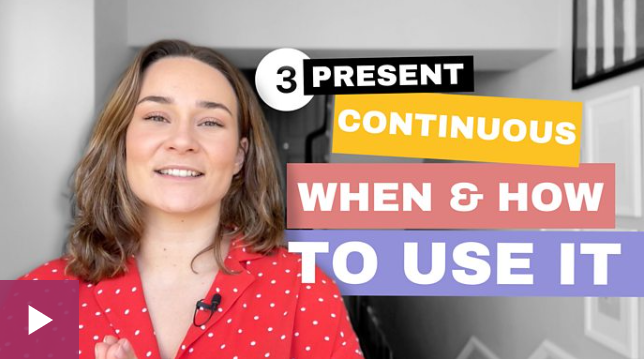USES OF PRESENT CONTINUOUS
Activities happening at the moment of speaking.
- Right now, I’m making a video, and you are learning English.
- The sun is shining now.
- My parents are working at the moment.
- The webpage is currently loading.
Useful vocabulary for activities happening now: at the moment, now, right now, currently, as we speak
Temporary situations happening around the present moment.
- I’m living in a noisy neighbourhood at the moment.
- My parents are working on a home decoration project this year.
- Susie is studying at university.
- My brothers are travelling the world.
Activities that are repeated a lot.
- He is constantly stealing my biscuits.
- It’s always raining in London.
- They are consistently arriving late to class.
- We are regularly testing the computers for viruses.
Useful vocabulary for repeated activities: constantly, always, consistently, regularly, repeatedly, continually, perpetually
Talking about change.
- His health is improving.
- The kids are growing up so quickly.
- The population of the town is increasing slowly.
- Everything in my life is changing.
Talking about future plans or arrangements.
- What are you doing this evening?
- I’m visiting my grandma.
- We’re watching a movie with Mum later.
- I’m getting the train at 4 o’clock this afternoon.
Useful vocabulary for future plans: at ____ (time), next Monday, next week/month/year/season, this afternoon/evening, tonight, tomorrow, tomorrow morning
STRUCTURE
For positive sentences, use the verb ‘to be’, then add ‘-ing’ to the main verb.
- I am walking
- You are walking
- He is walking
- She is walking
- It is walking
- We are walking
- They are walking
For negative sentences, add ‘not’ after the verb ‘to be’. We usually contract the form with an apostrophe.
- I am not walking > I’m not walking
- You are not walking > You aren’t/You’re not walking
- He is not walking > He isn’t walking/He’s not walking
- She is not walking > She isn’t walking/She’s not walking
- It is not walking > It isn’t walking/It’s not walking
- We are not walking > We aren’t walking/We’re not walking
- They are not walking > They aren’t walking/They’re not walking
To ask yes/no questions, change the order of the sentence so the ‘to be’ verb is at the beginning.
- Am I walking?
- Yes, you are
- No, you aren’t
- Are you walking?
- Yes, I am
- No, I’m not
- Is he walking?
- Yes, he is
- No, he isn’t
- Is she walking?
- Yes, she is
- No, she isn’t
- Is it walking?
- Yes, it is
- No, it isn’t
- Are we walking?
- Yes, we are
- No, we aren’t
- Are they walking?
- Yes, they are
- No, they aren’t
To ask for more information, add the ‘who, what, where, why, how, when’ question words at the beginning.
- Why am I walking?
- Who are you walking with?
- Where he walking?
- When is she walking?
- How are they walking?
- When are we walking?
